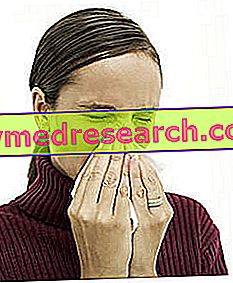Curated by Luigi Ferritto (1), Walter Ferritto (2) |
Complications
Allergic rhinitis is often underestimated, but in reality it can seriously worsen patients' quality of life; this deterioration is even comparable to that induced by asthma and other chronic diseases, which is why allergic rhinitis must be adequately treated.

Sleep also depends on good nasal function; therefore, during allergic exposure the nasal obstruction alters patients' sleep, with a consequent reduction in the ability to concentrate during the day and drowsiness.
Numerous studies have shown a worsening of daytime sleepiness, quality of life and sleep quality in rhinitics during allergic exposure. These changes are related to the severity of rhinitis, given that 80% of subjects suffering from moderate-severe rhinitis report a decline in their quality of life, compared to 40% of mild rhinitis.
Subjects with important symptoms are also those who have more days of absenteeism from work and a reduction in their work performance. The problem is particularly evident in pediatric age, when the symptoms of uncontrolled rhinitis cause irritability, concentration difficulties and a clear reduction in academic performance.
Prevention
The prevention of allergic rhinitis and associated diseases is essentially based on the removal of the allergen, in particular mites, animal derivatives and molds.
To reduce the risk of indoor allergies (indoors) it can be useful:
- remove dust mites, which reproduce in places where dust tends to accumulate (for example sheets and blankets, upholstered items of furniture and carpets);
- reduce the dandruff of domestic animals (for example by washing them once a week);
- prevent the infestation of cockroaches, which deposit the eggs and leave behind excrements that can trigger the onset of allergies;
- minimize molds, which take root in dark and damp places.
To limit the risk of outdoor (outdoor) allergy :
- engage in outdoor activities only when the concentration levels of pollen are low;
- avoid going out in the open air for long periods of time between 5 and 10 am, when pollen concentration levels are high;
- while driving, keep the windows closed to reduce contact with pollen;
- use an air conditioning system in the home and replace the filters frequently;
- to prevent the accumulation of pollen on the body, take a shower and wash your hair every day;
- change clothes when returning home;
- avoid contact with freshly cut grass and use a mask equipped with a pollen filter for gardening work;
- allow the laundry to dry at home and not in the open air (pollen can accumulate on stretched clothing);
- frequently wash pets that spend a lot of time outdoors to remove pollen from their fur.
Department of Internal Medicine Respiratory Physiopathology Unit "Athena" Villa dei Pini
Piedimonte Matese (CE)




